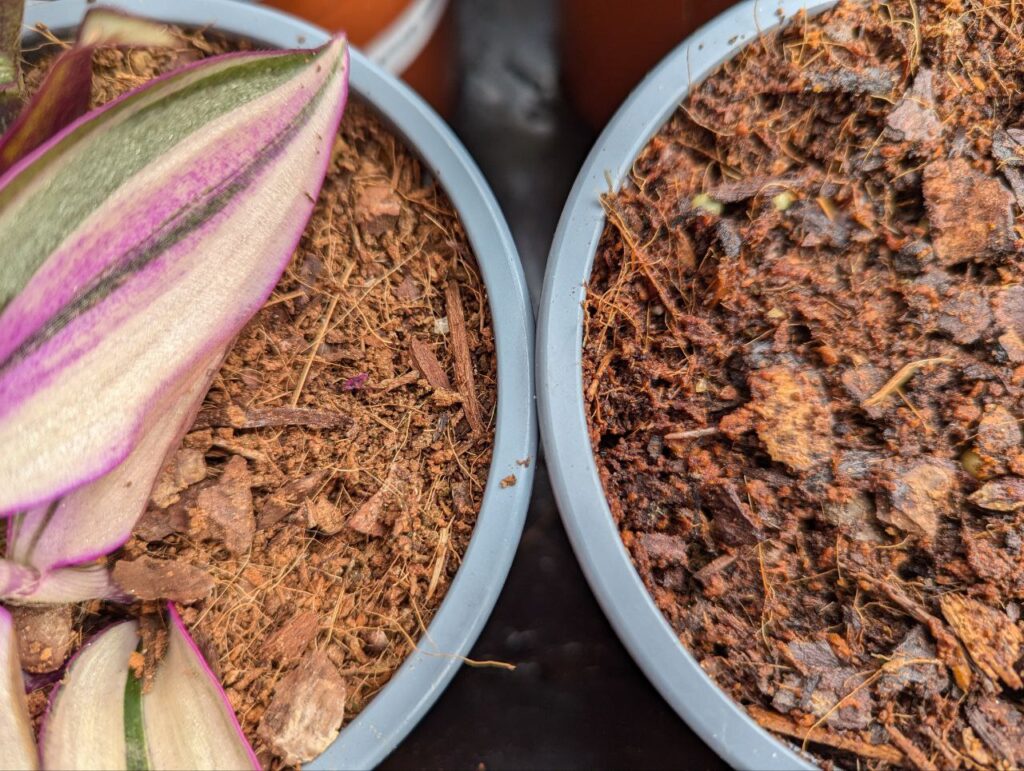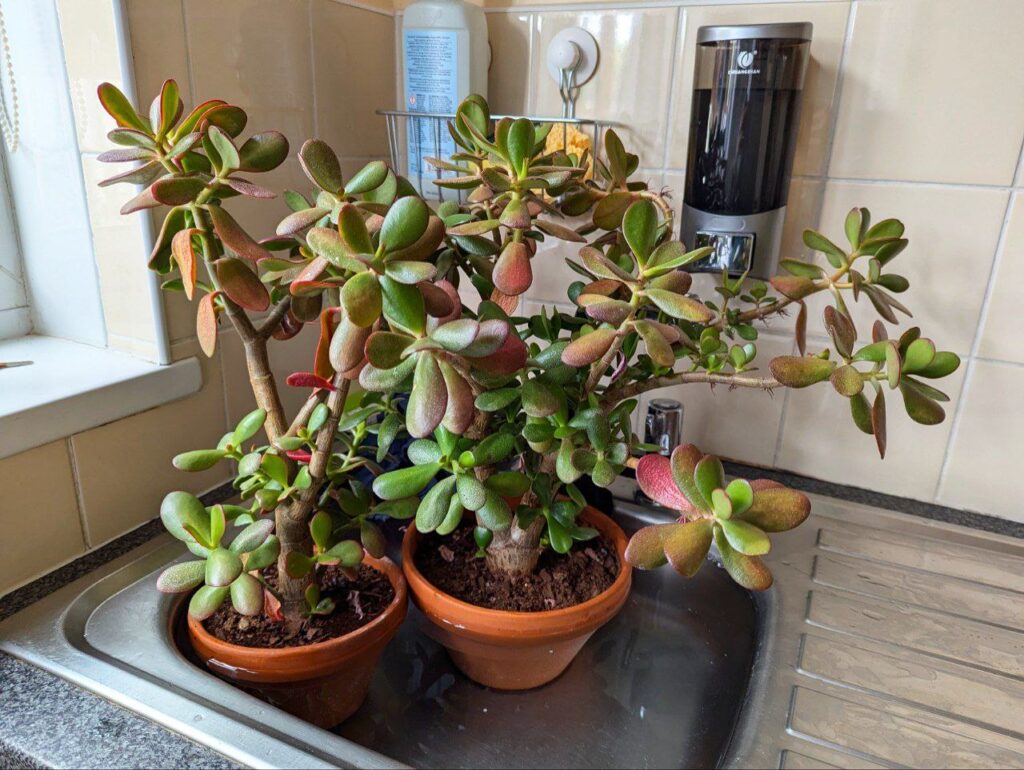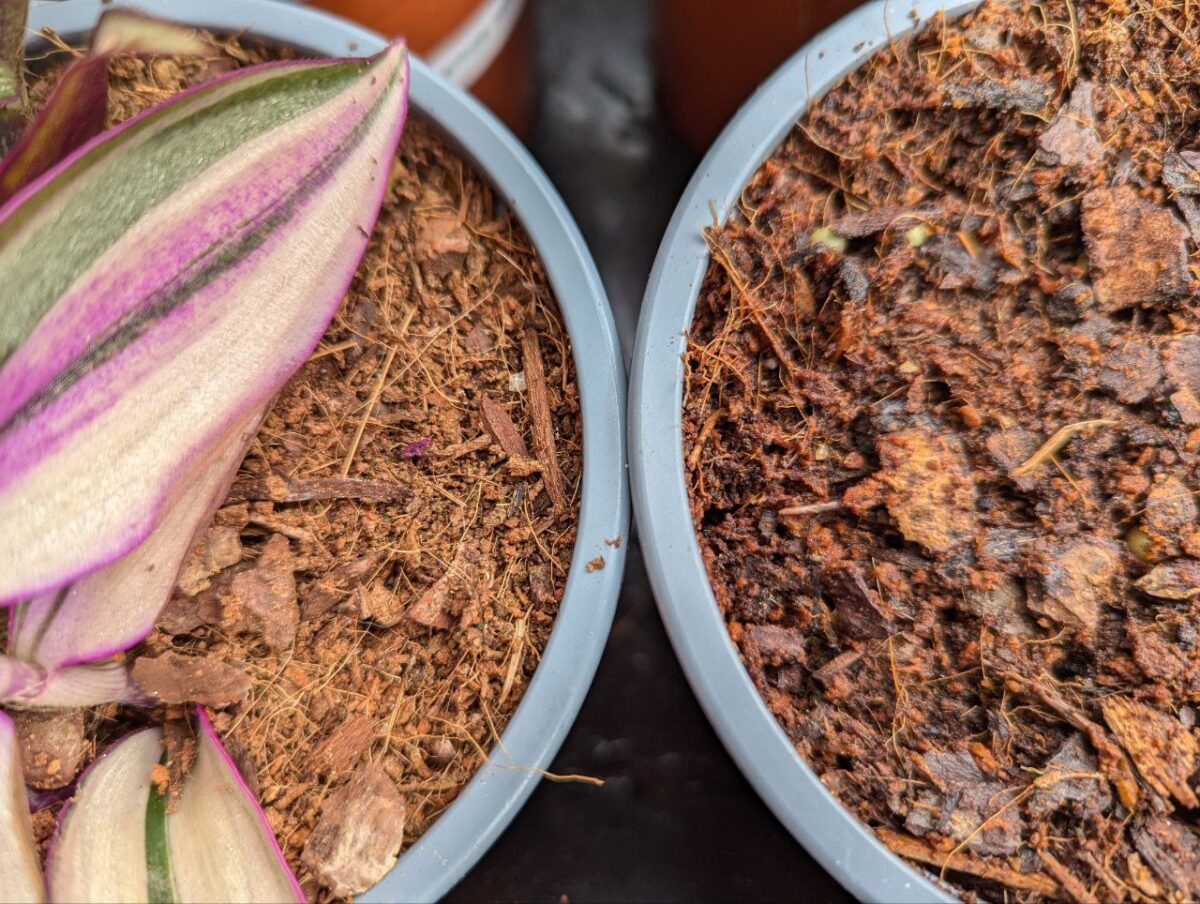Skip to: The golden rules // What is overwatering? // What is underwatering // How to water a plant // Conclusions
Watering is, of course, a fundamental part of growing container plants. It might seem very basic, but it’s also one of the most common causes of problems. In this article I’ll give three “golden rules” of watering, and explain how to apply them in practise.
The golden rules
The phrase “watering a plant” is misleading. What we’re actually doing is watering the soil*. The soil in turn makes that water available for the plant to help itself to. But we don’t control that part of the process. As growers our job is only to make the soil a suitable environment to meet the plant’s water needs.
So the three golden rules for watering plants are all about soil.
Some of these rules might seem counter-intuitive. They might even be the opposite of what you’re heard before! But following them carefully is the best way to keep your houseplants happy and healthy.
(*Note: I’m using “soil” as a generic term to refer to whatever growing media, potting mix, or substrate the plant is in. I’ll get more specific about growing media later.)
Golden Rule 1
Every time any container plant is watered, all of the soil should be fully saturated and then completely drained.
- Every single time. Even if the plant has recently suffered root damage from excess moisture. Even if it’s a fresh cutting being watered for the first time.
- Any container plant. Even succulents. Even cacti!
- All of the soil. All the way across the pot. All the way from the surface to the bottom.
- Fully saturated. Wet enough to squeeze out like a sponge. Wet enough that water runs all the way through the pot. (The pot does have drainage holes, right? The pot should always have drainage holes.)
- Completely drained. All the excess water should be allowed to pour out of the drainage holes and discarded. The container should never stay sitting in a pool of water.
Watering only a small amount and not saturating the soil will mean some of the roots never have access to water. That in turn means the plant won’t be able to absorb enough moisture to sustain itself over time.
The method of watering doesn’t matter, as long as it saturates the soil. You can pour water from above, or soak it in from below, or both. The important thing is to make sure that all of the soil in the container has actually absorbed water. If the soil can’t get fully saturated, something else needs to change. Either try a different watering method to soak the soil completely, or repot to refresh the soil.
Golden Rule 2
Every container plant should be watered when the soil reaches a certain level of dryness.
Not after a certain amount of days. Not when the plant wilts or looks a certain way. But when the soil itself is a certain dryness. Watering while the soil is still too wet, or letting the soil get too dry, will both harm plants over time.
There are lots of ways to examine the moisture level of the soil in a container. Look at the colour and texture of the top surface. Lift the pot to feel its weight. Stick a finger or skewer down into the soil to see if it’s wet in the middle. Pick up the container to see and feel the exposed soil at the drainage holes.
The correct level of dryness to wait for is determined by which plant is in the container. For a moisture-demanding plant, it will need watering again as soon as the top of the soil starts to dry. For a desert plant, it will need the soil to dry out completely all the way to the bottom before it gets watered again. Most houseplants are somewhere in between.
Golden Rule 3
It should take between three days and a month for the soil to reach the right level of dryness.
This rule is more of a guideline. The numbers aren’t exact, but they’re a range to aim for, because plants need the saturation-drying cycle to happen within a reasonable amount of time.
If a plant’s soil always dries out within a day of being fully saturated, it will struggle to stay well-hydrated in the long term because it won’t have enough time to take in the water it needs. And if the soil consistently takes several months to reach the right level of dryness, the plant’s roots will start to suffer from excess moisture before they get a chance to breathe.
In either of those cases, something else needs to happen to change the timing of the wet-dry cycle. It could be changing the soil or pot to adjust the water retention, or changing the humidity, lighting, or temperature of the environment to influence the rate of evaporation.

What is overwatering?
I often see new plant-owners say in a panic, “I think I overwatered my succulent yesterday!”. In fact, that’s impossible. Golden Rule 1 tells us that when it’s watering time, every plant should get the exact same treatment to fully saturate all the soil. You can never give a plant too much water in one go! If plants couldn’t handle being soaked, everything would die the first time it rained.
Overwatering is a chronic condition
It means watering too soon before the soil has dried out enough, repeatedly for a period of weeks or months.
It should be called oftenwatering, not overwatering.
So if you think you poured too much water through your plant yesterday? Congratulations, as per Golden Rule 1, you did it right!
If you’ve been watering while the soil was still wet for weeks or months, that might be a problem. If the roots never get enough time to breathe in between waterings, they will start to die and rot. In extreme cases, the bases of stems might rot through and detach entirely where they meet the soil.
It can be tempting, especially if you’re new to plants, to water them every day as a way of showing them care and attention. Resist that urge! Your plants will thank you. Get into the habit of checking the moisture level of the soil regularly, and if it hasn’t dried to the right level for the plant you’re growing, leave it alone.
Remember that the rate of drying won’t always be the same. Temperature, lighting, humidity, and the plants’ growth rate will all affect how fast it uses up the water in the pot. So don’t just water it once a week because it took a week to dry out when you first got the plant. You have to actually check, every time.
If the soil consistently doesn’t dry out enough after a month (Golden Rule 3), then you’ll need to take further action to fix the rate of that cycle. That doesn’t mean watering a smaller amount each time (Golden Rule 1)! It means repotting or changing the environmental conditions to help the soil dry out faster.
What is underwatering?
Just like overwatering, you can’t underwater a plant in a single day. Your plant might wilt dramatically if you let the soil dry out too much before the next watering. But it will most likely perk up as soon as it gets rehydrated. If plants couldn’t survive drying out, everything would die in the first warm week of summer.
Underwatering is a chronic condition
It means either:
- not saturating all the soil each time, or
- letting the soil get too dry before watering,
repeatedly for a period of weeks or months.
In the effort to protect plants from excess moisture, some people mistakenly think they should give only a small, limited amount of water at a time. But Golden Rule 1 tells us that’s the wrong approach. Doing this only allows the very surface of the soil to get wet. Most of the roots lower down never get any moisture, and the plant ends up not getting access to the water it needs even with seemingly frequent watering. Instead you should always fully saturate the soil at each watering, which gives all the roots the chance to absorb water.
Golden Rule 2 tells us that the soil should reach a certain dryness before watering – but not more dry than that. Healthy plants can survive brief wilting every so often after being left for too long. But if you consistently allow a plant to get very dehydrated in between waterings, it won’t be able to get enough moisture to sustain itself in the long term.
If your plant keeps wilting between waterings, try to monitor the soil more closely in future so you can water before it gets too dry. If a fully-saturated container dries out again within three days and you can’t keep up, it’s time to do something else to slow down that drying cycle, by repotting or changing the envirnomental conditions (Golden Rule 3).
Sometimes if a plant has been in the same pot for a long time – especially if it has been allowed to dry out a lot – the soil becomes so compacted it resists absorbing water at all. Even pouring water through the container might not perk up the plant, because the soil isn’t actually taking in any moisture for the roots to access.
So it’s possible that even though you think you’re following Golden Rule 1, the soil isn’t actually becoming saturated each time. You can check by sticking a finger into the middle of the pot when you’ve just watered it. If it’s still dry, you’ll need to try soaking the whole container, or repotting in fresh soil, to make sure it absorbs water properly.

How to water a plant: step-by-step guide
I’ve given a lot of top-level information about how watering works. Here is a concrete guide on putting it into practise.
1. Check.
Every day or two, stick your finger into the pot to feel the soil.
- If the plant is a fern or otherwise very moisture-demanding: check whether the top of the soil is starting to dry.
- If the plant is a cactus, succulent, or otherwise very drought-tolerant: check whether the soil is dry all the way to the bottom.
- If it’s another typical houseplant like an aroid: check whether the soil is dry about halfway down.
If the soil isn’t that dry yet, wait and check again tomorrow. If the soil is at least that dry, water it. It should be between three days and a month since it was last watered.
2. Water.
Either:
- Pour water over the suface of the soil until it pours out through the drainage holes, or
- Submerge the whole container in water and let it soak for half an hour or so, then remove it.
When you’re done, all the soil throughout the pot should be saturated and wet.
3. Drain.
Either:
- Let it sit over a sink or drain until it stops dripping, or
- Let it sit in a saucer for an hour or so, and then tip away whatever has built up in it.
And you’re done! If anything didn’t happen as expected during this process, it might be time to repot or change something else in the environment – check the detailed information in the earlier sections.
Conclusions
I wrote the golden rules as absolutes because they’re easier to understand that way, but of course nothing is truly absolute. I trust that people who are experienced enough with plants to question these rules will also be experienced enough to know how and when to “break” them.
For any plants that don’t require extremely unusual specialist care, the golden rules are the best way to keep them healthy in the long term. A regular cycle of saturation and drying keeps plants well-hydrated with healthy roots, and prevents both overwatering and underwatering.
Found this article useful?
If you want more great resources like this, you can help me keep making them with a regular payment on Patreon.

